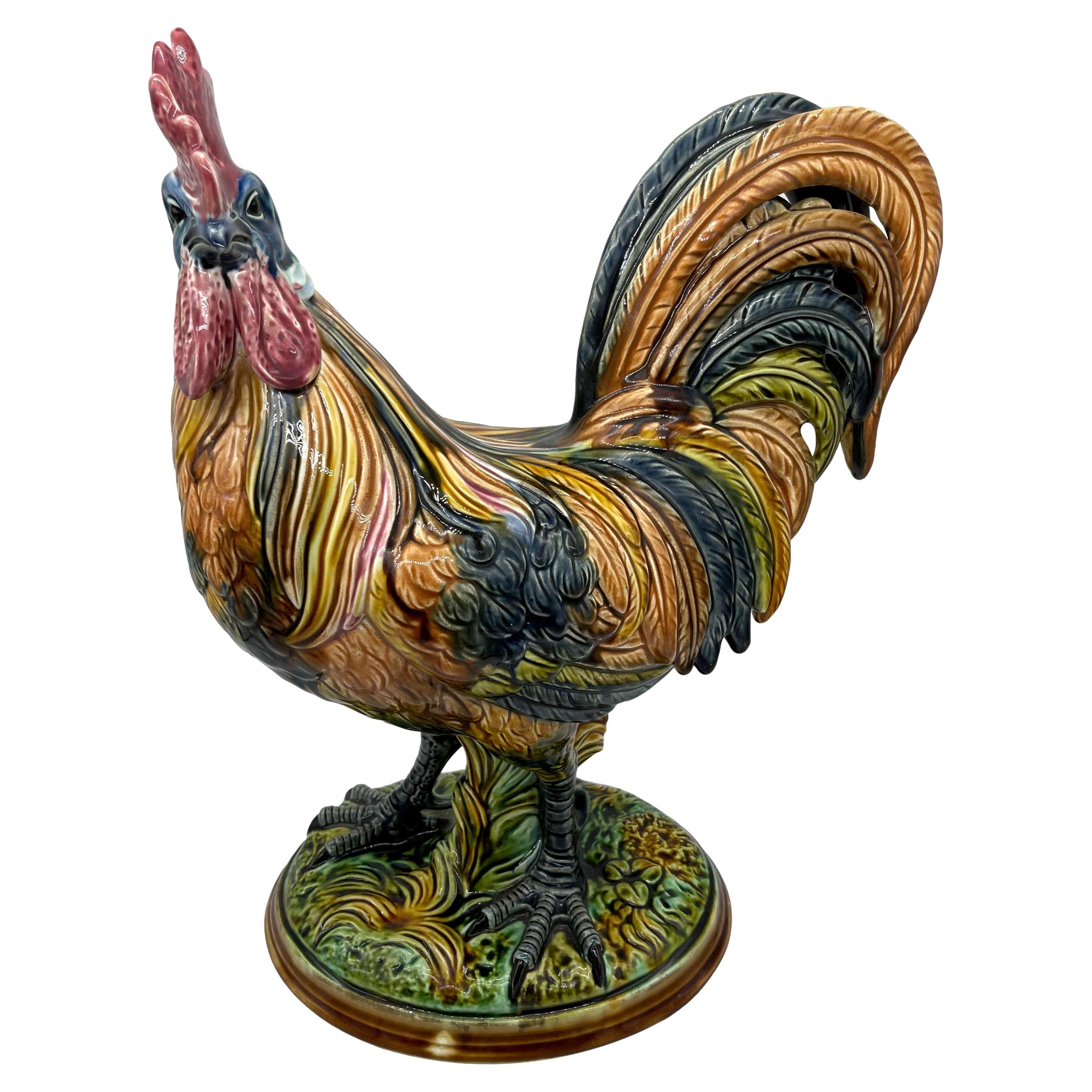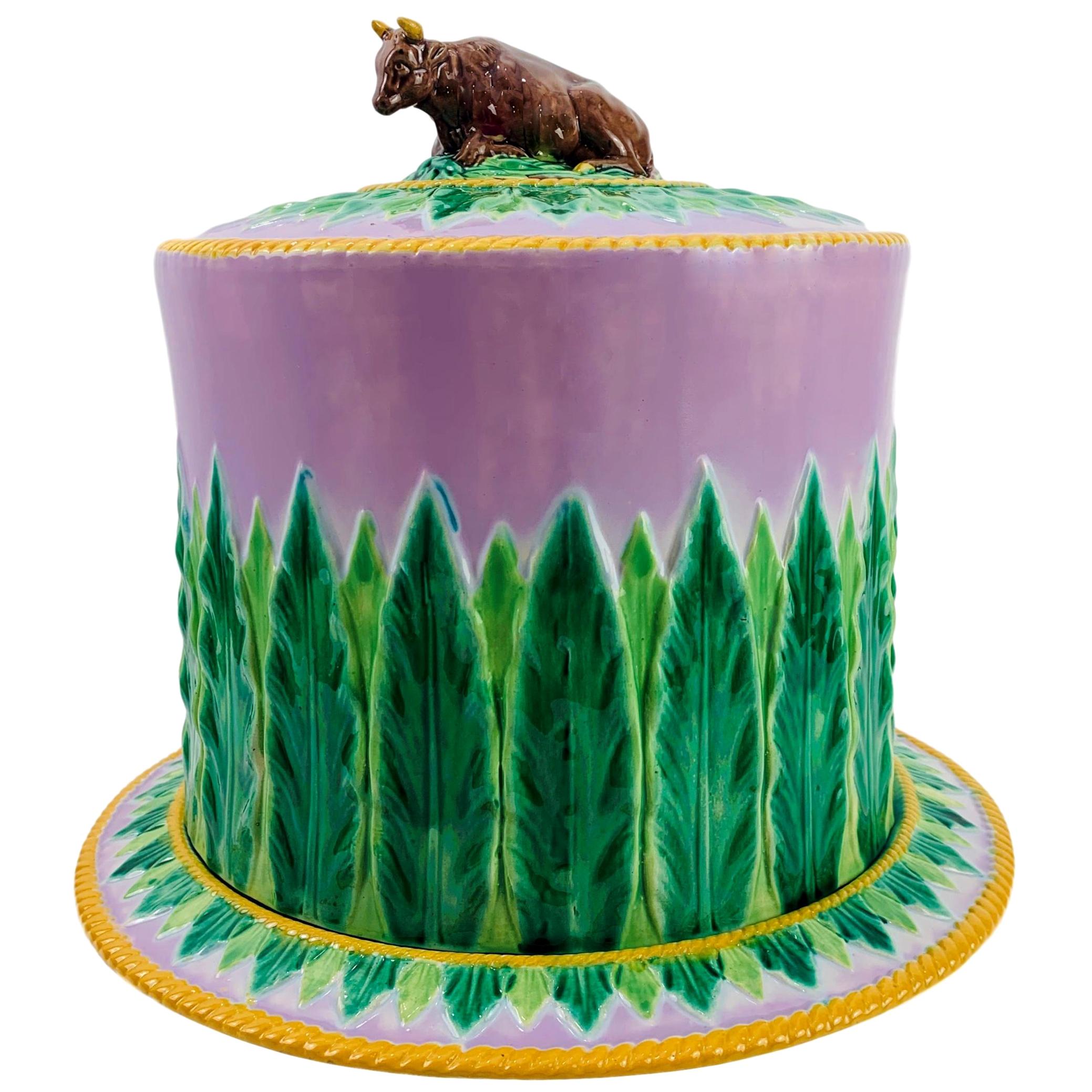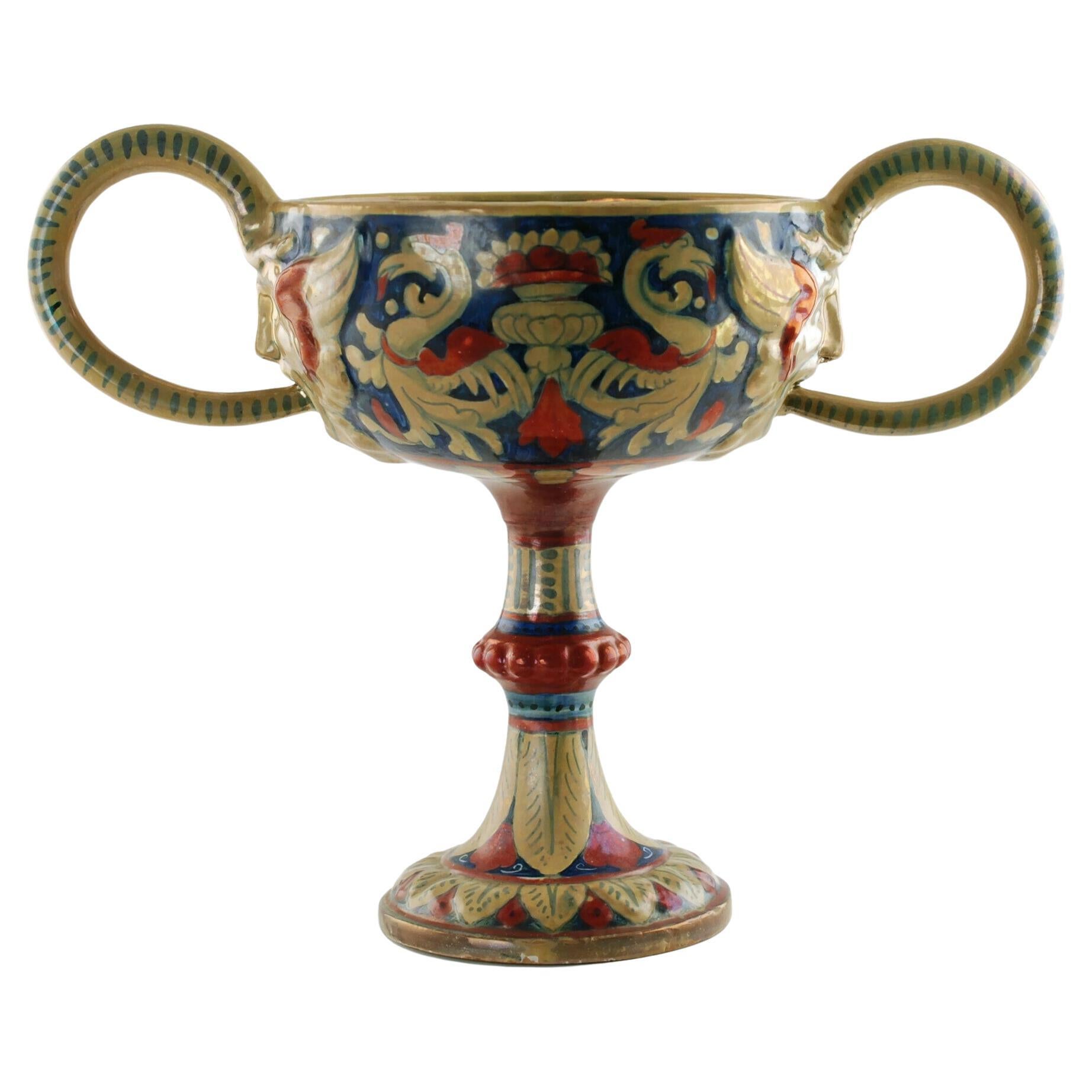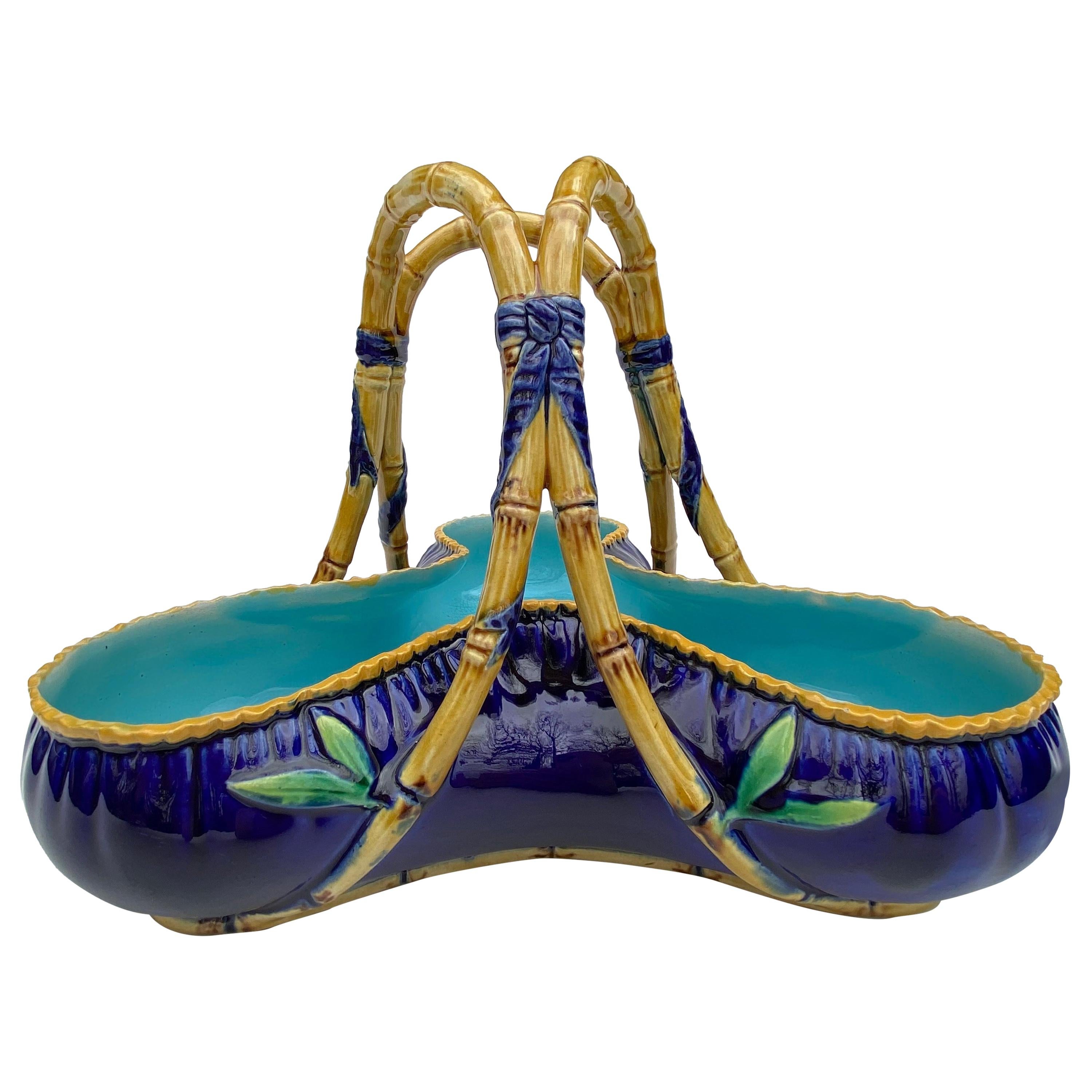Items Similar to Hugo Lonitz Majolica Table Jardinière Stand with Partridges, Oak Tree, ca. 1880
Want more images or videos?
Request additional images or videos from the seller
1 of 20
Hugo Lonitz Majolica Table Jardinière Stand with Partridges, Oak Tree, ca. 1880
About the Item
Hugo Lonitz Majolica figural table Jardinière stand, naturalistically molded as an oak tree, with a pair of partridges nesting among bulrushes and grasses, on a rustic mound-form, log and rockwork base, the reverse with impressed marks: Hugo Lonitz & Co. emblem, and design number '1204,' German, ca. 1880.
The website of the Majolica International Society makes an interesting observation on the probable derivation of Hugo Lonitz's animalier sculptures:
"Lonitz took much inspiration for many of his naturalistic majolica pieces from Black Forest carvings that were popular in Europe in the second half of the 19th century. Like the best Black Forest carvings of this era, Lonitz’s earth-toned majolica studies depicted lifelike detail so realistically that observers often have to look twice to ensure the piece hasn’t come to life."
For thirty years we have been among the world's preeminent specialists in fine antique majolica.
BOOK REFERENCES:
> Jeffrey B. Snyder, ANTIQUE MAJOLICA. Atglen, PA; Schiffer Publishing Ltd., 2005, p. 211 (full-page color illustration), and illustrated on the front cover.
> Mark F. Moran, MAJOLICA. Iola, WI: KP Books, 2005, p. 250.
> Helen Cunningham, MAJOLICA FIGURES. Atglen, PA: Schiffer Publishing Ltd., 1997, p. 129.
- Creator:Hugo Lonitz & Co. (Maker)
- Dimensions:Height: 13.13 in (33.36 cm)Width: 9 in (22.86 cm)Depth: 7 in (17.78 cm)
- Style:Victorian (Of the Period)
- Materials and Techniques:Majolica,Molded
- Place of Origin:
- Period:
- Date of Manufacture:1880
- Condition:Wear consistent with age and use.
- Seller Location:Banner Elk, NC
- Reference Number:
About the Seller
5.0
Recognized Seller
These prestigious sellers are industry leaders and represent the highest echelon for item quality and design.
Gold Seller
These expertly vetted sellers are highly rated and consistently exceed customer expectations.
Established in 1995
1stDibs seller since 2015
268 sales on 1stDibs
Typical response time: <1 hour
- ShippingRetrieving quote...Ships From: Banner Elk, NC
- Return PolicyA return for this item may be initiated within 7 days of delivery.
More From This SellerView All
- German Majolica Figural Rooster by Riedel Von Riedelstein, Dallwitz, ca. 1885Located in Banner Elk, NCMajolica Figural Rooster, naturalistically modeled as an alert cockerel, the feathers with mottled gold, brown and blue glazes, the comb and wattle glazed in pink and red, on an oval...Category
Antique 19th Century German Victorian Ceramics
MaterialsMajolica
- Large George Jones Majolica Cow Cheese Dome and Stand, Pink Ground, English 1873By George JonesLocated in Banner Elk, NCFull-Size George Jones Majolica Cow Cheese dome and stand (Stilton Dish), 11.75 height x 12.5 diameter inches, on a vivid deep pink glazed ground with str...Category
Antique 1870s English Victorian Ceramics
MaterialsMajolica
- George Jones Majolica Large 'Rose Basket' in Cobalt Blue, circa 1872By George JonesLocated in Banner Elk, NCGeorge Jones Majolica large 'Rose Basket' 9.5-in wide in cobalt blue, circa 1872. Impressed British Registry mark stamp to reverse for 17 February 1872. George Jones pattern number '...Category
Antique 1870s English Victorian Ceramics
MaterialsMajolica
- George Jones Majolica Strawberry Server Mounted by a Bird, English, circa 1870By George JonesLocated in Banner Elk, NCGeorge Jones Majolica Strawberry Server, ca. 1870, the trefoil dish naturalistically moldelled with blossoming strawberry plants and ferns on a turquoise and rustic ground, surmounte...Category
Antique 19th Century English Victorian Ceramics
MaterialsMajolica
- Green Majolica Strawberry Dessert Plate, English, ca. 1880Located in Banner Elk, NCGreen Majolica strawberry dessert plate, English, molded with strawberries and strawberry leaves, English, ca. 1880.Category
Antique 19th Century English Victorian Ceramics
MaterialsMajolica
- Minton Majolica Centerpiece Tray 15-in, Lotus Flower on Green Ground, Dated 1863By MintonLocated in Banner Elk, NCMinton Majolica centerpiece, naturalistically modeled as a pond bed with simulated water glazed in cyan blue, with green glazed lily pads and flowering pond lilies (lotus), and reeds glazed in various shades of green, with brown and ochre-glazed cattails molded in high relief to form the border, with a central lotus flower glazed in white and blue, concealing a solid brass original fitting for a candle, doubling as a receptacle for an (optional) additional tier which would have screwed into the fitting; the fitting is removable. Impressed marks to reverse: 'MINTON' and Minton date cypher for 1863; an impressed 'A' possibly for the designer, Thomas Allen...Category
Antique Mid-19th Century English Victorian Ceramics
MaterialsMajolica
You May Also Like
- Rubboli Lustre Majolica Double-Handled Compote with Mask Head DetailBy RubboliLocated in Cincinnati, OHThis early 20th century piece of Italian lustreware was made by the renowned Rubboli family pottery in the Umbrian town of Gualdo Tadino, Italy. Italian lustreware Majolica production traces its origins to the Renaissance. The art was revived in Gualdo Tadino during the last quarter of the 19th century, largely due to the efforts of ceramist Paolo Rubboli. Rubboli established his pottery in the region around 1870, and became known for the high quality of his distinctive cobalt, red and gold Neo-Renaissance lustreware. Rubboli's wife Daria and sons Lorenzo and Alberto continued Paolo's efforts after his death in 1890, and joined the newly formed consortium Societa Ceramica Umbria in 1920. Rubboli pieces dating to the period are marked with a blue underglaze "SCU" in a triangle mark along with a conjoined "PR" monogram in homage to Paolo's work. This large ceramic Neo-Renaissance Rubboli double handled compote is finished in cobalt, red and gold lustre. The piece consists of a round bowl at the top with elongated applied handles at either side, all of which rest upon a pedestal base. The bowl features two bas-relief winged mask heads on the exterior which have been depicted with open mouths sprouting handles in the form of serpent-like forked tongues. The exterior is also painted with pairs of imposing gryphons, each of which flank a large urn. The interior of the bowl is also heavily decorated and bears a fantastical winged lion set at the center of a series of scrolling acanthus leaves and urns, best seen in image 8. The remainder of the piece is finished with foliate and geometric motifs. It is of note that a similar piece was included in the traveling exhibit of important Majolica and lusterware entitled 'The Rubboli Collection - Italian lustre pottery in Gualdo Tadino' held in the Chiesa Monumentale di San Francesco between July 17 – October 3, 2010. The compote is in excellent original condition with no restorations or repairs. There are some glaze skips present on the piece as well as minor chips at the base of the pedestal foot which do not detract from the appearance of the compote and are mentioned for accuracy. The underside of the piece bears the blue underglaze Rubboli family Società Ceramica Umbra mark cited above consisting of the letters “SCU” within a triangle along with the entwined Paolo Rubboli 'PR' monogram, which was used from 1920 to 1931. The 3lb 5oz compote stands...Category
Vintage 1920s Italian Renaissance Revival Centerpieces
MaterialsCeramic
- Partridge Majolica Game Pie Dish Made by George Jones, Ca. 1867By George JonesLocated in Fort Lauderdale, FLA majolica game pie dish designed by George Jones circa 1867-1869 in the ‘Partridge’ shape. The game pie dish is decorated with a lovely turquoi...Category
Antique 1860s English Victorian Serving Pieces
MaterialsEarthenware, Majolica, Pottery
- Plate Centerpiece Tray Wall Dish Decorated Ornament Majolica Platinum LusterBy deBlonaLocated in Recanati, ITOur fancy ceramic plate is handmade and hand-painted in Italy following the original Renaissance painting technique, unchanged over time, which we observe to the letter: it is decorated in majolica painted in a monochromatic antique blue and decorated by a platinum luster, comprising a wavy mixtilinear rim which is divided by eight bands which are arranged on the following with a radial structure: half of them, the largest ones, are painted with refined floral motifs; the others, which alternate with the previous ones, are devoid of ornaments. The same decorations present in the brim are shown in the large cable, which are characterized by natural elements such as flowers, leaves and berries. This beautiful piece can be hung as a decorative wall dish...Category
21st Century and Contemporary Italian Modern Ceramics
MaterialsPlatinum
- Majolica Jardinière Leaves and Snake Johann Maresch, circa 1880By Johann MareschLocated in Austin, TXA naturalist Majolica jardinière with different kind of leaves, large ferns leaves, a branch on the front and a nest with birds threatened by a snake signed Johann Maresch (1821-1914...Category
Antique 1880s Austrian Rustic Planters and Jardinieres
MaterialsMajolica, Ceramic
- Plate Centerpiece, Tray Decorated Bowl, Wall Dish Majolica Aquamarine, In StockBy deBlonaLocated in Recanati, ITThis exclusive ceramic plate is handmade and hand-painted in Italy following the original Renaissance painting technique, unchanged over time, which we observe to the letter: it is d...Category
21st Century and Contemporary Italian Modern Centerpieces
MaterialsCeramic, Majolica
- Plate Centerpiece Bowl Tray Decorated Ornament Majolica Blue White Deruta ItalyBy deBlonaLocated in Recanati, ITThis splendid ceramic plate is handmade and hand-painted in Italy following the original Renaissance painting technique, unchanged over time, which we observe to the letter: it is de...Category
21st Century and Contemporary Italian Modern Ceramics
MaterialsCeramic, Majolica
Recently Viewed
View AllMore Ways To Browse
Glass Trees
Glass Tree
Silver Tree
Majolica Ceramics Antique
Antique Glass Trees
Antique Silver Tree
Reverse Glass Tables
Tree Glass Table
Oak Glass Front
International Silver Co
Victorian Illustration
Interesting Antique Silver
Oak And Silver Table
Pair Of 19th Century Oak Tables
Victorian Antique Illustrations
Oak Table Pair Antique
German Oak Antique
Antique Oak German Furniture





